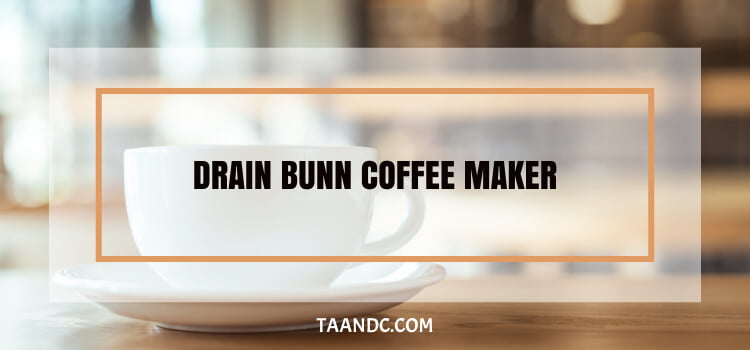Today, I’m excited to share my experience with you on How To Drain Bunn Coffee Maker? Over the years, I’ve had my fair share of brewing adventures, and draining the coffee maker is a routine task that can sometimes be overlooked. So, let’s dive right into it. When it comes to draining your Bunn coffee maker, the first thing you’ll want to do is ensure it’s unplugged and cool to the touch. Then, remove the water reservoir and any remaining coffee from the carafe. Next, look for the release valve near the bottom of the machine – it’s usually located on the side. Just open it up and let gravity do its thing.

Step-by-step Guide On How To Drain Bunn Coffee Maker
Regularly draining a coffee maker is a simple yet essential task that ensures optimal performance and extends the lifespan of your equipment. To help you through the process, we have created this step-by-step guide specifically for Bunn coffee makers. Following these instructions, you can easily remove any lingering water and mineral buildup, keeping your machine in pristine condition for a delicious cup of coffee every time. So, let’s dive into the details and learn how to drain your Bunn coffee maker effectively.
Turn Off The Coffee Maker & Unplug It
Before starting the draining process, it is crucial to ensure that your coffee maker is turned off and unplugged. This step is of the utmost importance as it prevents any potential damage to the machine and eliminates any safety risks that may arise. By turning off the coffee maker, you are safeguarding it against accidental activation during the draining procedure, which could lead to electrical mishaps or even injury. It’s important to note that simply pressing the power button on your machine is not sufficient; you must unplug it from its power source.
When unplugging, make sure to remove the switch from the outlet altogether. Some users may only turn off their coffee maker using the power button without disconnecting it from the power source. This can keep some machine elements active and pose a risk while draining. Therefore, thoroughly unplug your Bunn coffee maker before emptying it to ensure adequate maintenance and personal safety.
Remove The Brew Funnel & Empty Any Remaining Coffee
After turning off and unplugging the coffee maker, the next step is to remove the brew funnel. To do this, gently lift the brew funnel from the Bunn coffee maker. Before proceeding further, ensuring no remaining coffee is in the brew funnel is essential. You can achieve this by tapping it lightly or using a spoon to empty any leftover grounds. Removing any remaining coffee can ensure a thorough draining process and prevent residue from interfering with future brewing cycles.
Locate The Drain Valve & Attach A Hose
The next step is to locate the drain valve and attach a hose to drain a Bunn coffee maker. The drain valve is typically situated at the bottom of the coffee maker. Its lever or knob can identify it. Take a moment to inspect your machine and find the drain valve’s precise location.
Once located, prepare a long enough hose to reach a suitable draining area. Attach one end of the hose securely to the drain valve, ensuring it is tightly fastened to prevent leaks. The hose will serve as a conduit for directing the water flow out of the machine during the draining process. With the hose attached, you are ready to proceed with effectively emptying the water from your Bunn coffee maker.
Open The Drain Valve To Let The Water Flow Out
Once the hose is securely attached to the drain valve of your Bunn coffee maker, it’s time to open the valve and let the water flow out. The drain valve is typically situated on the bottom of the machine, and attaching a hose ensures that the water is directed correctly. To begin draining, carefully open the drain valve by turning or pulling the lever/knob in the appropriate direction as indicated by your machine’s design. It’s crucial to ensure the drain valve is fully open to drain all the water from your coffee maker effectively.
Be patient, as gravity allows the water to flow through the hose and out of your machine. Monitor your draining area to ensure all water has been successfully emptied. Once you are confident that no water remains in your Bunn coffee maker, proceed with cleaning and maintenance as necessary.
Close The Drain Valve & Remove The Hose
After successfully draining your Bunn coffee maker, closing the drain valve and removing the hose is essential. Begin by ensuring the drain valve is securely locked to prevent leaks. Turn or push the lever/knob in the opposite direction from when you opened it, ensuring it is fully completed. This will prevent any water from escaping once you remove the hose.
Next, carefully disconnect the hose from the drain valve, ensuring it does not spill any remaining moisture. Gently detach the hose and set it aside for cleaning or storage. With the drain valve closed and the hose removed, you have completed the draining process for your Bunn coffee maker. It is now ready for further use or maintenance as needed. Enjoy your freshly drained machine and a delicious cup of coffee!
Tips & Precautions For Draining Bunn Coffee Maker
Before you begin draining your Bunn coffee maker, it’s important to remember a few tips and precautions. By following these guidelines, you can ensure a safe and effective draining process while preserving the functionality and longevity of your machine. From turning off and unplugging the coffee maker to properly closing the drain valve, these tips will help you navigate each step quickly and confidently. Let’s explore some valuable advice for draining your Bunn coffee maker.
Use Caution When Handling Hot Water
When draining a Bunn coffee maker, it is essential to exercise caution when handling hot water. Hot water can cause burns and injuries if not handled carefully. Wearing oven mitts or gloves when touching hot surfaces is recommended to ensure your safety. Additionally, always use a heat-resistant container to collect the draining water and avoid direct contact with the hot surfaces of the coffee maker. These safety precautions can prevent accidents or injuries while effectively draining your Bunn coffee maker. Remember to prioritize safety at all times during this process.
Clean & Sanitize The Coffee Maker After Draining
After draining a Bunn coffee maker, it is crucial to clean and sanitize it to ensure its optimal performance and prevent the growth of bacteria and germs. Regular cleaning helps remove mineral buildup and oily sludge that can accumulate over time, improving the taste of the coffee. Using a mild, non-abrasive cleaner specifically designed for coffee makers is recommended.
Start by washing the removable parts, such as the carafe and filter basket, with warm, soapy water. Then, wipe down the exterior surfaces of the coffee maker using a damp cloth. To sanitize, you can run a cycle with a mixture of white vinegar and water or use a commercial coffee machine cleaner following the manufacturer’s instructions. Regularly cleaning and sanitizing your Bunn coffee maker can maintain its performance and ensure every cup of coffee is fresh-tasting and free from harmful contaminants.
Regularly Monitor The Water Quality
Regularly monitoring the water quality in your Bunn coffee maker is crucial to ensure optimal performance and taste. To determine when draining is necessary, observe the water for any signs of mineral buildup, discoloration, or unusual odors. These can indicate a need for draining to remove accumulated deposits affecting the coffee’s flavor and the machine’s functionality.
Suppose you notice a significant amount of mineral buildup or the water appears discolored or has an off-putting odor. In that case, it is time to proceed with draining. By regularly checking the water quality and addressing any issues promptly, you maintain the taste of your coffee and extend the lifespan of your Bunn coffee maker. Remember to follow the previously outlined draining process to ensure effective cleaning and maintenance.
FAQ
How often should I drain my Bunn coffee maker?
Draining your Bunn coffee maker every three months or whenever you notice a decrease in performance or taste quality is recommended.
Can I use the leftover water from draining for other purposes?
Drinking water that has been drained from your Bunn coffee maker is not recommended. This water may contain residue, minerals, or impurities that can affect its quality.
Do I need special tools to drain my Bunn coffee maker?
No, you do not need any special tools to drain your Bunn coffee maker. Please disconnect the power, place a container under the drain valve, and open it to release the water.
How do I clean and sanitize my Bunn coffee maker after draining?
After draining, cleaning and sanitizing your Bunn coffee maker is essential. Refer to the manufacturer’s instructions for properly cleaning and sanitizing your model.
What should I do if I notice mineral buildup after draining my Bunn coffee maker?
If you notice mineral buildup in your Bunn coffee maker, try using a descaling solution specifically made for coffee makers, even after draining. Follow the instructions provided for the descaling solution to achieve the best results.
Conclusion
Regularly draining your Bunn coffee maker offers numerous benefits that enhance your coffee experience and extend the lifespan of your machine. By preventing limescale buildup, you ensure optimal performance and improve the taste and temperature of your coffee. Properly draining the device also helps maintain proper water flow, preventing clogs or damage from freezing water in colder climates.



